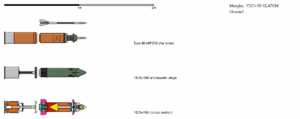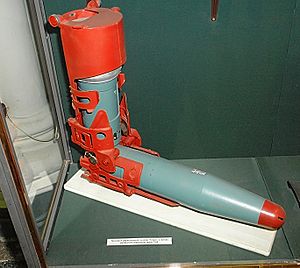YDCh-19
| YDCh-19 | |
|---|---|
 YDCh-19G anti-tank variant, with a cross-section of the missile and booster below. At top is a 125mm APFSDS round for comparison. | |
| Type | Gun-launched ATGM |
| Place of origin | |
| Service history | |
| In service | 2001-present |
| Used by | |
| Production history | |
| Designer | Hanbyŏl State Arsenal |
| Designed | 1994-2000 |
| Produced | 2001-present |
| Specifications (YDCh-70A) | |
| Weight | 17.4 kilograms |
| Length | 71 centimeters |
| Diameter | 125 mm |
| Wingspan | 29 cm (fins extended) |
| Propellant | solid fuel rocket |
Guidance system | SACLOS beam-riding |
Steering system | aerodynamic surfaces |
The YDCh-19 (Formal designation: 19식 대전차 유도탄 / 一九式對戰車誘導彈, il-gu-sik daejŏncha yudotan, "Type 19 anti-tank missile;" Short designation 유대차-19 Yudaecha-ilgu "YDH-19") is a beam-riding anti-tank guided missile developed in Menghe during the 1990s and fielded in 2001. It is designed to be fired from the 125mm gun of the JCh-5 tank, as a replacement for the previous YDCh-13 gun-launched ATGM. It is also compatible with the newer JCh-6, though the latter tank is now equipped with the more capable YDCh-73 in priority units.
Design and development
In 1983, Menghean tank forces fielded the YDCh-13 ATGM, a license-produced derivative of the Letnian 9K112 Kobra. The model licensed in Menghe was based on the 9M112 base version, introduced in 1976, with none of the accuracy and penetration upgrades from the 9M112M and 9M112M2. The age of the base design was compounded by the poor quality of Menghean manufacturing in the 1980s and 1990s, resulting in poor accuracy and inconsistent reliability. Live-fire tests regularly encountered hit probabilities below 60%, sometimes losing the missile in its own dust cloud, other times with complete failure after leaving the barrel.
Work on a replacement missile began in 1994, led by the Hanbyŏl State Arsenal - the Menghean Army's internal design bureau. Rather than improve the YDCh-13, which was already a 20-year-old design, the Hanbyŏl team decided to develop a missile which was functionally similar but new in design. In addition to updated guidance and control electronics, the new design featured a tandem-charge warhead for improved effectiveness against reactive armor and a spin-stabilized rocket motor to reduce deviations from the flight path. It also came with the option of an "elevated" or "ballistic" flight path, in which the missile flies 5 meters above the direct line of sight to the target and drops down to direct line of sight when 800 meters away, reducing the probability of a mid-course collision with terrain and reducing the dust cloud produced by low travel over the ground.
The entire missile body was also within the length constraints of the projectile section of the JCh-5's carousel autoloader, eliminating the need to mate two missile body sections during loading. This was reportedly one cause of high missile failures on the YDCh-13. The rear section of the autoloader compartment was taken up by a booster stage which similarly improved reliability over the YDCh-13's model, using a standoff chamber and venting apparatus to reduce damage to the missile's rear tracking equipment upon propellant combustion.
When the YDCh-19 was formally unveiled in 2002, many foreign defense analysts noted its similarity to the Letnian 9M119 Svir/Refleks, speculating that it may be an unlicensed copy. A Letnian legal team reportedly investigated the issue, but was unable to secure compensation. As more information about the YDCh-19 came to light, it has become apparent that the missile itself borrowed no internal technology from the 9M119, and in fact its guidance system and spin-stabilization borrowed components from the 9M134 Valtorna, licensed in Menghe as the YDCh-18 in 1997. Only the booster section appears to be copied from the 9M119's 9Kh949 unit, likely using publicly available photographs of a cutaway rather than directly obtained blueprints.
Variants
- YDCh-19G:
- The basic variant of the YDCh-19, with a tandem HEAT charge for anti-tank work. Claimed penetration of 800mm after ERA.
- YDCh-19N:
- A dedicated anti-personnel and anti-obstacle variant. With a command-detonated smart fuse in the nose and a prefragmented charge in the body, it can be programmed to detonate over the target, for use against soft-skinned vehicles and infantry in trenches or behind cover. It can also be used against hovering or slow-moving helicopters.
Service
The two-piece YDCh-19 is compatible with all Letnian-derived 125mm autoloader systems, including those on the T-74 and later tanks. Conversion of the tank for YDCh-19 compatibility mainly involves switching out the laser rangefinder for a combined rangefinder/designator module. The YDCh-19 can also be used by the JCh-6 and JCh-8, which have in-line bustle autoloaders. Menghe has actively marketed the system to its neighbors and allies, including Ummayah.
Since 2017, the more capable YDCh-73 has replaced the YDCh-73 in high-priority units, though as of 2019 stockpiled YDCh-19s are far more numerous. Based on the YDCh-72, the YDCh-73 uses non-line-of-sight controls, infrared imaging guidance, and a top-attack trajectory, all of which improve its effectiveness but also increase procurement costs.
